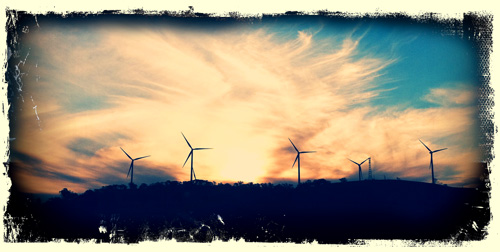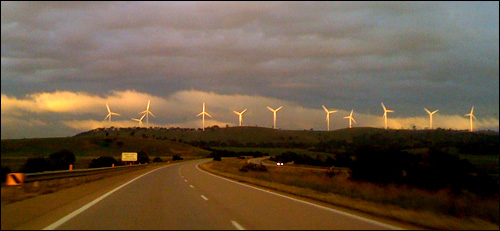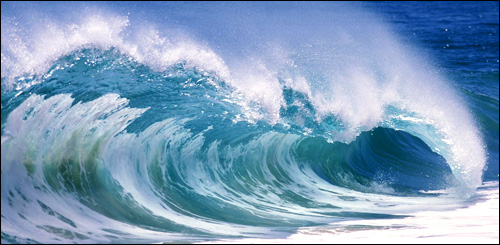Wed 21 Mar 2012
Windmills of Their Minds
Posted by anaglyph under Australiana, Gadgets, Hokum, In The News, Politics, Science, Skeptical Thinking, Technology, WooWoo
[10] Comments

Acowlytes! Do you suffer from quivering? Nervousness? Fear? A compulsion to flee? Visual blurring? Panic? Nausea? Can you rule out having glimpsed Tony Abbott in budgie smugglers as the cause of these ailments? Then it is possible, dear friends, that you may have Wind Turbine Syndrome, or WTS. A more fitting acronym for this affliction would probably be WTF? but I digress.
Wind Turbine Syndrome is aligned with other forms of paranoia-induced woo such as EHS (electrical hypersensitivity) which evince a plethora of diffuse and non-specific symptoms ((“Symptoms of electromagnetic radiation sickness are for example sleep disturbances, dizziness, heart palpitations, headache, blurry sight, swelling, nausea, a burning skin, vibrations, electrical currents in the body, pressure on the breast, cramps, high blood pressure and general unwell-being.”)) attributed to technology of which the sufferers (and their doctors) are afraid and/or ignorant (or just plain don’t like).
WTS is rather more irritating than EHS, though, because of its implementation in a political agenda. The story generally goes like this:
A land owner makes a deal with a power company to host (usually for a reasonably healthy figure) a bunch of wind turbines on a nice windy ridge on his/her property. Other people who are within visual distance of the turbines (and sometimes not even that) who are not making any money out of them, claim to have developed WTS. There is not one single case of WTS being developed by the franchisee of a wind farm operator. ((As far as my research has been able to determine, anyway. If anyone has heard of one I’d love to get a link.))
For reasons that are not at all clear to me, many country people seem to have taken against wind turbines with an amount of vitriol that is perplexing. Personally speaking, I think the lazy rotating blades are quite elegant and attractive, and the airy whooshing sound they make fairly inoffensive.
But WTS is not, of course, about common sense. It’s about political agendas, ignorance and NIMBYism.
You will recall that the first push by objectors to wind farms took the form of ‘Oh noes!! The horrible mincing blades are killing all the birds!’ This, from people who up till then had pretty much never even noticed the green speckled parrot or the golden-throated lark. ((Fictional birds because there are so many that are supposedly affected by wind turbines that you may as well say ‘any bird’)) Well, it turns out that on the list of things-that-birds-need-to-worry-about, wind farms are pretty damn far down, so, with these newly-adopted eco concerns of the anti-wind lobby not getting much traction, another bogeyman was needed to put the scare into folks. They found one with WTS. Deciding without evidence that something is, a priori, bad, and then finding multiple, disparate reasons to attempt to support your supposition, is, as you will all know by now, a glittering trademark of irrational thinking.
I was going to tell you next about exactly what it is that’s supposed to be the cause of WTS, but after reading pages of print about it, I’m finding that difficult. Mostly, though, the Big Bad is infrasound: sound frequencies that are so low they are literally inaudible to humans. Other sources claim that it’s ultrasound – high frequencies that are above the range of human hearing.
Dr Nina Pierpont, a New York paediatrician and self-styled expert on Wind Turbine Syndrome (she lays claim to coining the term) says:
…infrasonic to ultrasonic noise and vibrations emitted by wind turbines cause the symptoms
To be clear, she is saying that the problem is all the sound they make, from the highest part of the audio spectrum to the lowest. This kind of catch-all generalizing should immediately ring your woo-woo alarm bells.
In The Independent where the above quote originates, Dr Pierpont goes on to say that:
…the wind turbine companies constantly argue that the health problems are “imaginary, psychosomatic or malingering”. But she said their claims are “rubbish” and that medical evidence supports that the reported symptoms are real.
‘Rubbish’? That would be an effective scientific rebuttal if ever there was one. Professor Gary Wittert, the head of Medicine at the University of Adelaide, would be one person who would take exception to to Dr Pierpont’s claims that medical evidence supports WTS. Using data from the Australian Pharmaceutical Benefits Scheme, Professor Wittert has demonstrated that a sampled population of around 10,000 people living in the vicinity of wind farms in Victoria and South Australia shows no variation in quantities of usage of sleeping pills or cardiovascular medications from that which can be seen in the overall general population. Either people who live near wind farms aren’t seeking treatment for their WTS, or it doesn’t exist. This kind of data is, of course, exactly what would expect to see if WTS was a psychosomatic condition experienced by a small number of impressionable people rather than a discrete medical phenomenon in the community at large. Prof Wittert’s figures have still to be published and peer-reviewed, but we know that even when they are found to be solid (as they will be) the anti-wind farm campaigners will simply start crying that he’s a wind farm shill.

Setting aside the statistical science for a moment, and wandering briefly into my own field of expertise, let’s consider that claim that infrasound is the cause of the WTS. First, there is no medical evidence at all to suggest that infrasound itself has detrimental impact on human health unless encountered at enormous levels – levels well in excess of what you’d find even directly underneath a wind turbine. When you know that low frequency sound can be detected in your bones, it’s the sort of thing that seems like it might be possible, but that’s about it – no-one has collected data on such speculations. ((It’s perfect territory for woo – a vaguely plausible mechanism that is ‘sciency-sounding’ enough to give it a sort of ersatz currency.)) So to prove that wind farms are producing infrasound that affects human health detrimentally, you need to do three separate things: show that wind turbines produce infrasound in the first place, demonstrate that infrasound has adverse effects on humans and then establish that the amount of infrasound coming from the turbines is sufficient to trigger those adverse effects. So far, the data accumulated for each of these scenarios is not at all promising for advocates of WTS.
Without even doing that, though, there is a much more persuasive argument against infrasound being harmful to humans. Let’s take a situation that arises in nature where large volumes of infrasound (and ultrasound and everything in between for that matter) are generated in a constant and repetitive manner, just as wind turbines are supposed to do…

Yes, that’s right – the sea. Crashing ocean waves create at least as much infrasound as a wind turbine, probably more by several orders of magnitude. And yet, living by the ocean has not been demonstrated by any science I’ve ever seen to cause people to exhibit any of the symptoms of WTS. On the contrary, the sound of the surf is considered, by anyone who is lucky enough to have a beach house, to be restful and relaxing. ((But God made the sea, right, so that’s OK.))
Another insidious aspect of the anti-wind farm lobby when it comes to WTS is their habit of attempting to align the wind power industry with the tobacco and asbestos industries. This is, of course, the cynical employment of the logical fallacy of Weak Analogy (mixed with a bit of conspiracy-theory style paranoia). In other words, they’re saying that because the tobacco industry and the asbestos industry claimed their products were causing no human health problems and were found to be engaged in coverups, then it follows that the wind power industry is doing the same. There is no logical equation that you can make between those two things – it’s nothing more than a semantic trick designed to befuddle sloppy thinkers. What will speak here, is the science, as it did in the cases of tobacco and asbestos. So, what’s the state of the science on the side of the WTS advocates? Not very persuasive at all. ((And, like all pushers of pseudoscience, when the science is not on their side they freely wheel out the anecdotal evidence, the testimonials and the conspiracy theories.))
Nina Pierpont, who is a vocal objector to wind farms, bases all her science on one small self-generated study (10 families who were already ‘diagnosed’ as having WTS), that was sloppy in protocol, was based on subjective self-reporting and was not controlled. It’s the kind of experiment that would get you a C- if you handed it in to your science teacher. In the UK, the NHS found that Dr Pierpont’s study:
…provides no conclusive evidence that wind turbines have an effect on health or are causing the set of symptoms described here as “wind turbine syndrome”. The study design was weak, the study was small and there was no comparison group.
In Australia, Sarah Laurie, an unregistered doctor and ‘Medical Director’ of the climate denialist affiliated Waubra Foundation is the chief ‘expert’ campaigner for people who supposedly have WTS. Laurie claims to have conducted research into the causes of WTS, but what she offers up is embarrassingly spare and scientifically awful. This article at Crikey examines Sarah Laurie’s claims and highlights an hysterical ‘Explicit Cautionary Notice’ from the Waubra Foundation that effectively challenges wind farm companies with a series of claims that are highly dubious. It is without doubt designed as a propaganda tool rather than as a document of sincere concern. The notice refers to Nina Pierpont’s study, incorrectly endorsing it as ‘peer reviewed’ which it was not. ((Well, not in the properly understood scientific sense of the term, anyway. Pierpont showed her results to some friends, and then published the positive things any of them said. This is the same kind of peer review that made me Scientist of the Year in 2011.)) It also raises the spectre of ‘Vibroacoustic Disease’, a malady which is contentious in the field of scientific medicine, and is certainly irrelevant when dealing with the sound levels generated by wind turbines. ((Vibroacoustic disease is associated with people who are subjected to extremely loud noise for extensive periods of time. Think military personnel on cargo aircraft, or engine-room workers on ships. Even so, pinning the problem on infrasound is speculative. These kinds of noisy environments are assaulting workers with exceptional levels of sound of all frequencies, and separating out infrasound as the culprit would take a specific kind of research that – to my knowledge – has never been undertaken.))
Now, I want to make it clear that I do believe it is quite likely that most sufferers of so-called WTS are experiencing the symptoms they claim. Based on a rational appraisal of the science we have, though, it’s just not reasonable to conclude that those symptoms have got anything at all to do with any mechanical effects of wind turbine operation. An extremely balanced examination, by commentator Dave Clarke, sets out the state of play in the WTS debate with amazing clarity. Clarke examines every facet of the WTS phenomenon in thoughtful detail. It is effectively distilled down into one simple sentence:
It seems that complaints regarding nearby wind farms, regarding illness or simply annoyance, are often related to negative feelings about the wind farms.
In other words, for reasons that are hard to determine (but are most likely to do with politics or NIMBYism), people who don’t want the wind farms near them get stressed enough about it to make themselves ill. That is all.
At the very least, this explanation must be unequivocally ruled out before the promoters of Wind Turbine Syndrome can even begin to make claims that wind turbine technology is, by some unknown mechanism, causing the illness, and that ‘Big Wind’ is conspiratorially endeavouring to make it look like it’s not.
[Many thanks to Dr Rachael Dunlop for some of the source materials for this post]







